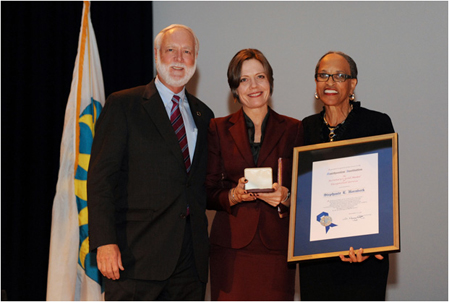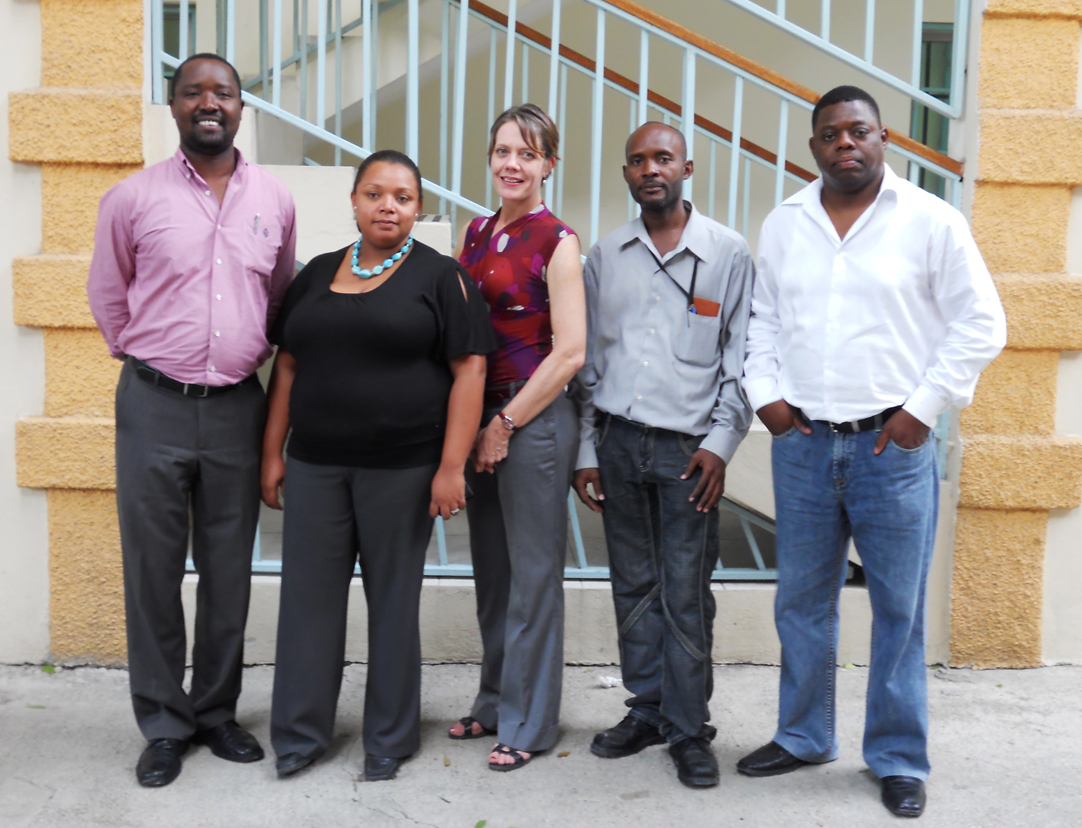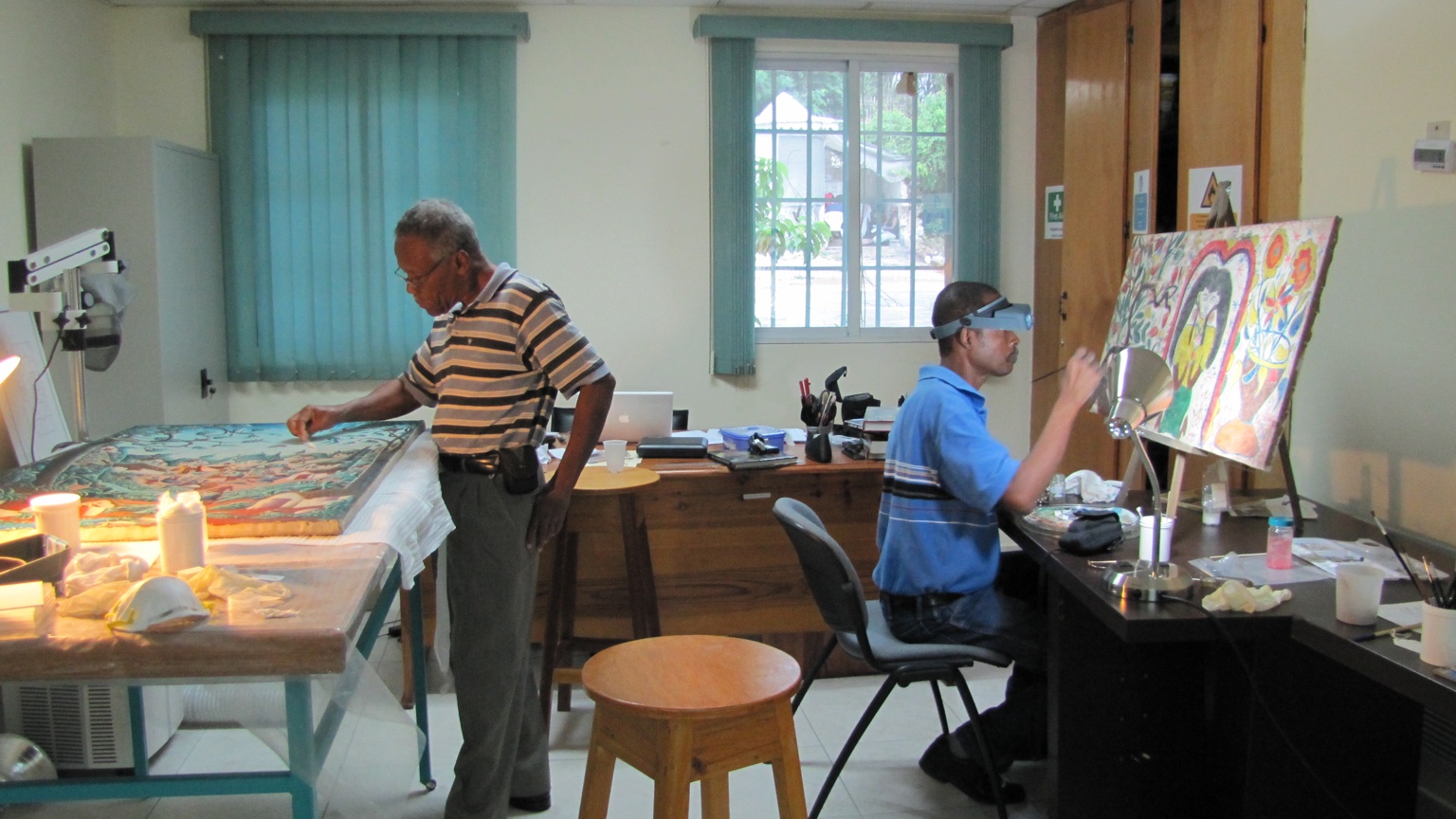
Projects

Krannert Art Museum, University of Illinois Urbana-Champaign (2023)
In 2023, Stephanie and colleagues on her team, including Fiorella Lavado (at right), provided conservation services to assist colleagues at the Krannert Art Museum with preparing 25 pre-Hispanic Andean (Peru) textiles, featherworks, and organic objects for display in reimagined permanent galleries opening in Fall 2024. These condition assessments, documentation, and treatments built on prior assessments of colleagues from the Metropolitan Museum of Art and the Textile Museum/George Washington University. Treatments involved the reversal of invasive older mounts (with glue, tape, stitching); stabilization of loose components; repair of broken elements; surface-cleaning; attachment of secondary supports; and aesthetic integration. Consultations also included recommendations for storage and display.

Stanley Museum of Art, University of Iowa (2021-2022)
In 2021- 2022, Stephanie provided conservation services to assist colleagues at the Stanley Museum of Art with the inaugural installation of their new museum building, which opened to the public in August 2022. Stephanie treated numerous African objects, representing diverse cultural groups and composed of a variety of materials and media. Treatments involved the stabilization of loose components; repair of broken elements; surface-cleaning; paint consolidation; filling losses; and inpainting for aesthetic integration. She also consulted on mounting and display methods.
To learn more please see Nexus-Art-and-Science

Caryatid Conservation Services, Miami (2010-2017)
From 2010-2017, this practice was based in Miami, FL, where we specialized in the conservation of museum quality objects. Our five-person team provided a full range of conservation services to 15 museums throughout Florida, as well as to select private collectors in Florida, New York, and Washington, DC. Museums clients included the Harn Museum of Art, Norton Museum of Art, Perez Art Museum Miami, Ringling Museum of Art, Rubell Family Collection, Tampa Museum of Art, and the Wolfsonian Museum.

Major projects included: project management of de-installation of Chinese permanent galleries (Norton Museum of Art, 2016); sampling ancient South American ceramics for dating tests and assessing and treating objects and textiles for a large museum exhibition of ancient Andean art (Lowe Art Museum, 2015); installation and de-installation of ancient Egyptian artifacts (Bolton Museum loan to Palm Beach Museum of Science, 2014-2015); survey of 170+ Asian objects and sculptures and treatment of 30 of them (Ringling Museum of Art, 2014-2015); installation of African textiles, apparel and regalia for the Harn Museum of Art (2011). We demonstrated our commitment to conservation education by offering paid pre-program internships to five assistants.

Smithsonian Haiti Cultural Recovery Project (2010-2016)
From 2010-2012 Stephanie served as Chief Conservator of the Smithsonian Institution Haiti Cultural Recovery Project in Port-au-Prince, Haiti. After Haiti’s devastating 6.8 magnitude earthquake in 2010, the project was formed to collaborate with and support colleagues at cultural institutions. Stephanie directed conservation efforts to support the recovery of damaged art works, monuments, books and documents. Project conservators aided in the training of 100 Haitian colleagues and assisted 20 public and private institutions in recovery and preservation of their collections. Collaborative project efforts resulted in the recovery of nearly 30,000 works.

For her work , Stephanie was awarded the Smithsonian Secretary’s Gold Medal for Exceptional Service. She is the only conservator in the award’s history to receive the honor. Citation: “In grateful recognition of her service to the Smithsonian Institution the Secretary’s Gold Medal for Exceptional Service is presented to Stephanie E. Hornbeck. As Chief Conservator of the Cultural Recovery Center she preserved Haiti’s material cultural heritage for future generations by leading American, international, and Haitian experts and trainees in professionally treating more than 30,000 works of art, artifacts, rare books, and historical documents damaged and endangered by the devastating earthquake of 2010.”




From 2013-2016, Stephanie participated in the transition from the post-earthquake cultural recovery project to the establishment of a new permanent conservation center at Quisqueya University. She advised and made recommendations on the design of the purpose-built Center. Once built, she guided a team in outfitting the Center with the equipment and supplies procured for the Smithsonian Haiti Cultural Recovery Project. Stephanie periodically traveled to Port-au-Prince to facilitate the transition, meet with Quisqueya colleagues and project partners, develop a curriculum template for conservation training, and to identify potential collaborative projects.
Look here for more detailed information about the project:
“The Art of Recovery: Art conservator Stephanie Hornbeck led an international effort to save Haiti’s precious cultural heritage one painting and cut sculpture at a time.” Wellesley Magazine Fall 2011
“The Journey to Recovery: A Tale of Earthquake Damage and Repair in Haiti” by Stephanie Hornbeck and Viviana Dominguez. The story of the dramatic damage context and advanced treatment of a Stivenson Magloire painting broken into 22 fragments by the 2010 earthquake. Hornbeck and Dominguez Blog Smithsonian Institution Archives
“Communicating the Smithsonian Haiti Cultural Recovery Project: Outreach and Reportage” American Institute for Conservation (AIC) 40th Annual Meeting (Albuquerque), Outreach Session on May 11, 2012. The panel discussion was moderated by Stephanie Hornbeck and included panelists: Eric Pourchot, Viviana Dominguez, Junior Norelus, and Saori Kawasumi.
Conservators Converse: Communicating the Smithsonian Haiti Project
Kurin, R., Saving Haiti’s Heritage: Cultural Recovery after the Earthquake. Washington, DC: Smithsonian Institution, 2011. http://haiti.si.edu/book.html. Hornbeck essays:
“Developing the Center’s Professional Culture” (pp. 90-91)
“The Center’s Conservation Program” (pp. 128-131)
“Preserving the Centre d’Art Collection” (pp. 137-139)
“Saving the Murals” (pp.152-153)
“Training as Legacy” (p. 168)
“Conservation: From the Tragic to the Uplifting” (pp. 184-186)

Nevelson Sculpture Conservation Treatment & Blog Series (2013)
In 2013, Caryatid Conservation Services undertook the treatment of two sculptures by Louise Nevelson, Dream House XLIII (1973) and Untitled (c. early 1980s), in the collection of the Perez Art Museum Miami (formerly the Miami Art Museum). The Museum was awarded a Bank of America Art Conservation Project Grant, to support the treatment and the production of a documentary film about the project by The M Network.
Sculptor Louise Nevelson (American, born Leah Berliawsky in the Ukraine, 1899-1988) was a major figure in 20th century art; Nevelson lived and worked in New York. After experimenting with various styles and media, she moved into abstraction in the late 1950s and found wide acclaim with her large-scale, monochromatic sculptures—typically wood assemblages painted white, black, or on occasion a metallic color. Like many Nevelson sculptures, the two works in the PAMM collection are comprised of wood elements attached to a wood substrate and painted flat black. Conserving art created by 20th century artists can involve navigation between the sometimes-competing demands of preservation of the physical art work and respect of artistic intent. Complex issues are at play and may include: artistic intent, conservation ethics, authenticity, exhibition installation, and the preservation of original materials vs. restoration.
This blog series described the project, as it evolved, featuring guest bloggers from Caryatid Conservation, the Perez Art Museum Miami (PAMM),The M Network and ARTEX Fine Art Services. In presenting the perspectives of scholars, conservators, film makers, and shippers, detailed windows will open onto the specialized work of those involved in this project. Read the series here: Caryatid Conservation Nevelson Blog Series
Caryatid Conservation abides by the Code of Ethics and Guidelines for Practice of the American Institute for Conservation